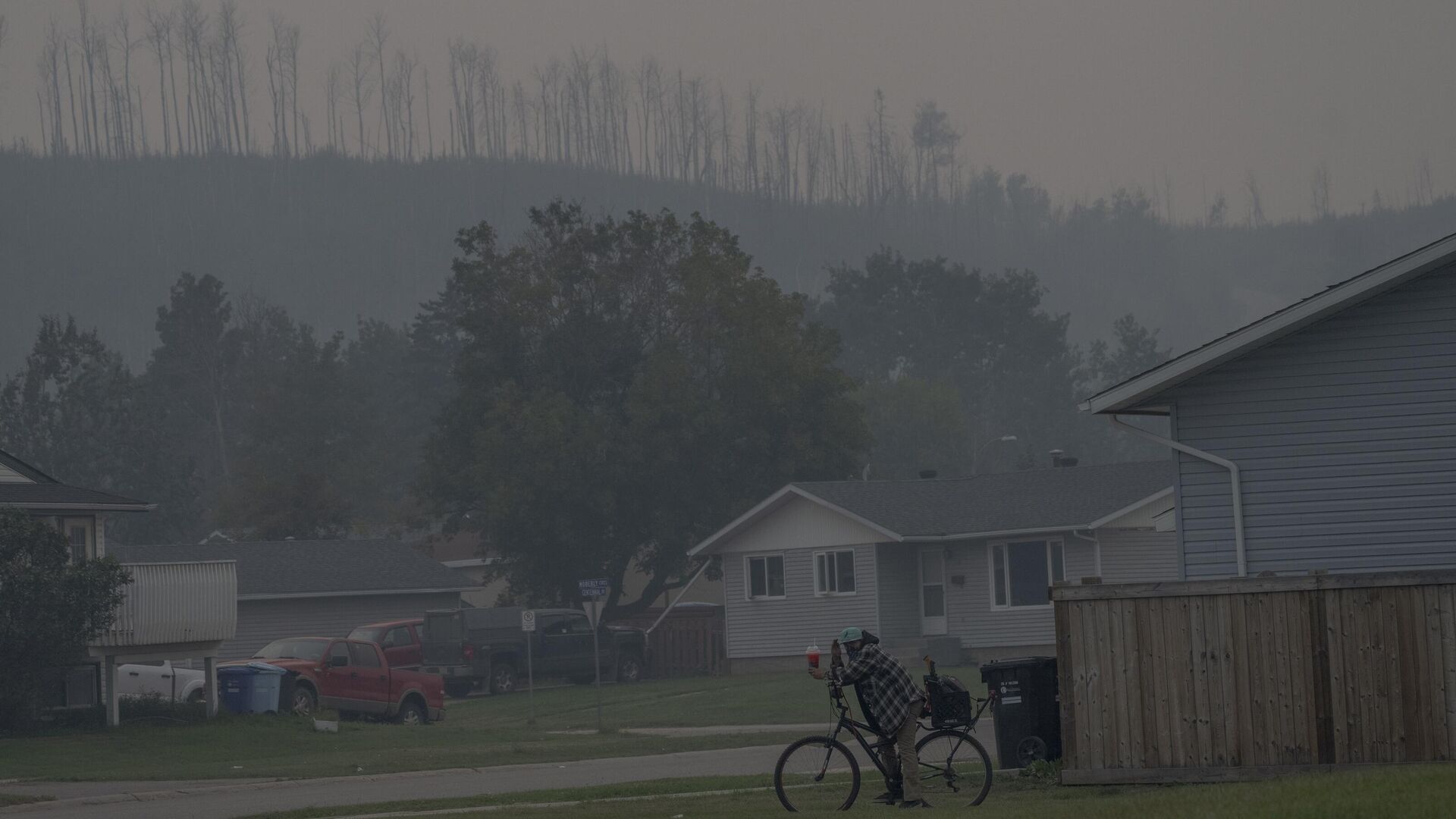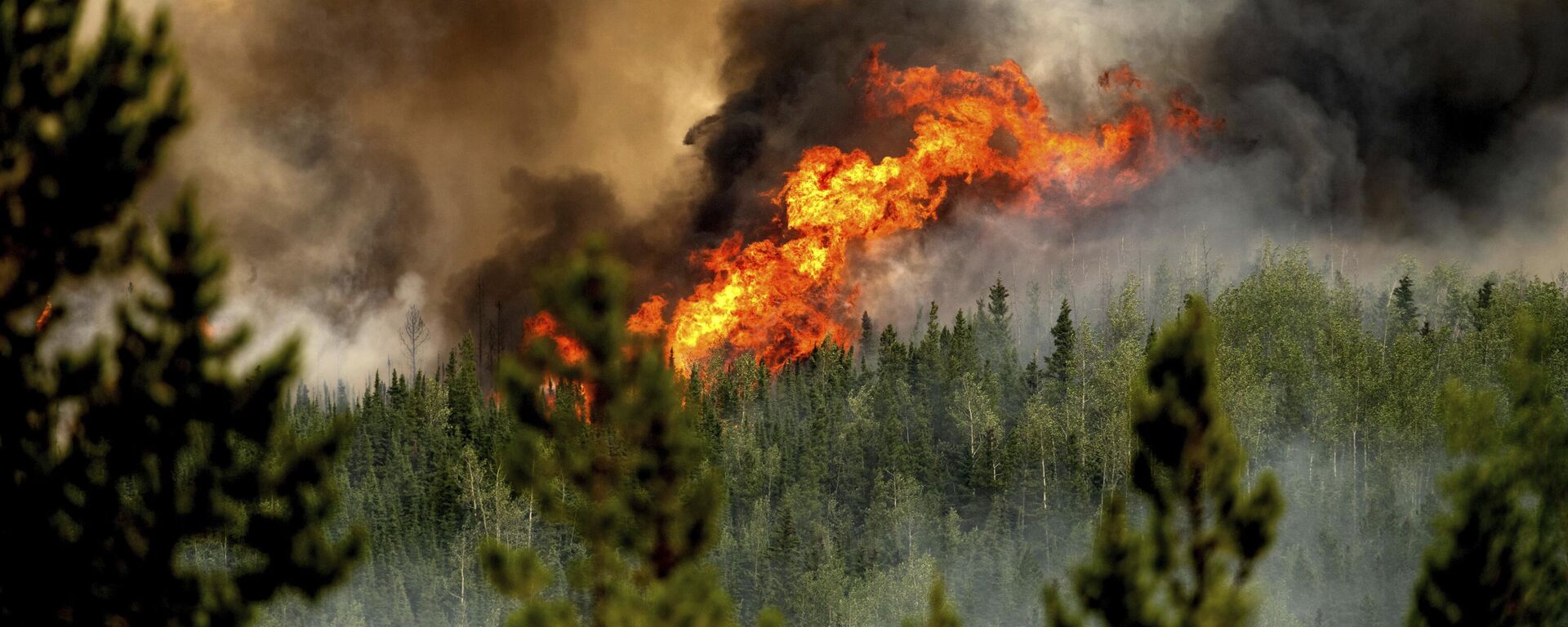https://sputnikglobe.com/20240628/canadas-2023-wildfires-produced-four-times-more-emissions-than-planes---study-1119158967.html
Canada's 2023 Wildfires Produced Four Times More Emissions Than Planes - Study
Canada's 2023 Wildfires Produced Four Times More Emissions Than Planes - Study
Sputnik International
Canada’s wildfires last year smashed records for the largest area burned in the country’s history. Another record the wildfires broke includes the highest carbon emissions in record for the country.
2024-06-28T04:46+0000
2024-06-28T04:46+0000
2024-06-28T04:46+0000
americas
canada
environmental protection agency (epa)
world
society
wildfire
wildfires
wildfires
smog
air pollution
https://cdn1.img.sputnikglobe.com/img/07e8/06/1c/1119159691_0:243:3208:2048_1920x0_80_0_0_cb0dfdcfcd5d8b2a2f67979df8927912.jpg
Canada’s wildfires last year smashed records for the largest area burned in the country’s history. Another record the wildfires broke includes the highest carbon emissions in record for the country. The 2023 wildfires emitted nearly 480 megatonnes of carbon - almost five-times the average for the past 20 years and made up 23% of the total global wildfire carbon emissions that year, The Copernicus Atmosphere Monitoring Service (CAMS) reported. World Resources Institute and the University of Maryland researchers sought to find out how damaging impacts from the Canadian wildfires last year. They believe the fires put about 3.28 billion tons (2.98 metric tons) of heat-trapping carbon dioxide into the air, The Guardian reported citing a study published in Thursday’s Global Change Biology.The researchers found that the fire produced nearly four times as much carbon emissions as airplanes do in a year, which is about the same amount of carbon dioxide that about 647 million cars create for the environment in a year, The Guardian said citing data from the Environmental Protection Agency (EPA).While the forest will eventually grow back and help isolate carbon in the future, it will take decades to do so, said Jacob Bendix, a Syracuse University geography and environment professor who was not a part of the study. At least four experts who spoke to The Guardian said that climate change played a crucial role in Canada’s extreme wildfire last year; as the planet grows warmer, fires become more common.The fires also had a disastrous impact on the environment as well. They significantly impacted the air quality across the Northern Hemisphere, including parts of Europe and China, Earth.com reported citing a study from the Institute of Atmospheric Physics (IAP).The wildfires resulted in unprecedented levels of PM2.5 which are fine particulate matter with diameters of 2.5 microns or less that are harmful to a person’s health. The fires also destroyed Canada’s forest ecosystems, including habitats, vegetation and food sources for wildlife.
https://sputnikglobe.com/20240516/wildfires-rage-across-canada-as-last-years-zombie-fires-spring-to-life-1118463500.html
americas
canada
world
Sputnik International
feedback@sputniknews.com
+74956456601
MIA „Rossiya Segodnya“
2024
News
en_EN
Sputnik International
feedback@sputniknews.com
+74956456601
MIA „Rossiya Segodnya“
Sputnik International
feedback@sputniknews.com
+74956456601
MIA „Rossiya Segodnya“
canada, wildfire, canadian wildfires, environment, study, emissions, global warming, climate change, carbon dioxide, fires, wildfires, canada, zombie fires, wild fire, extreme weather conditions, extreme weather, climate change, hot climate, forest fire, wild fire, wildfire, hot weather, flames, fire flames, flames of fire, holdover fires, zombie fires
canada, wildfire, canadian wildfires, environment, study, emissions, global warming, climate change, carbon dioxide, fires, wildfires, canada, zombie fires, wild fire, extreme weather conditions, extreme weather, climate change, hot climate, forest fire, wild fire, wildfire, hot weather, flames, fire flames, flames of fire, holdover fires, zombie fires
Canada's 2023 Wildfires Produced Four Times More Emissions Than Planes - Study
The 2023 wildfire season burned a whopping 16.5 million hectares of land compared to an average 2.5 million hectares of land that are typically burned in Canada per year. And the study’s authors calculated that the forest burned a total of nearly 30,000 square miles (77,574 sq km) and made up 27% of global tree cover loss last year.
Canada’s wildfires last year smashed records for the largest area burned in the country’s history. Another record the wildfires broke includes the highest carbon emissions in record for the country. The 2023 wildfires emitted nearly 480 megatonnes of carbon - almost five-times the average for the past 20 years and made up 23% of the total global wildfire carbon emissions that year, The Copernicus Atmosphere Monitoring Service (
CAMS) reported.
World Resources Institute and the University of Maryland researchers sought to find out how damaging impacts from the Canadian wildfires last year. They believe the fires put about 3.28 billion tons (2.98 metric tons) of heat-trapping carbon dioxide into the air,
The Guardian reported citing a study published in Thursday’s Global Change Biology.
The researchers found that the fire produced nearly four times as much carbon emissions as airplanes do in a year, which is about the same amount of carbon dioxide that about 647 million cars create for the environment in a year, The Guardian said citing data from the Environmental Protection Agency (EPA).
Forests “remove a lot of carbon from the atmosphere and that gets stored in their branches, their trunks, their leaves and kind of in the ground as well. So when they burn all the carbon that’s stored within them gets released back into the atmosphere,” explained James MacCarthy, the study’s lead author and a research associate with WRI’s Global Forest Watch.
While the forest will eventually grow back and help isolate carbon in the future, it will take decades to do so, said Jacob Bendix, a Syracuse University geography and environment professor who was not a part of the study. At least four experts who spoke to The Guardian said that climate change played a crucial role in Canada’s extreme wildfire last year; as the planet grows warmer, fires become more common.
The fires also had a disastrous impact on the environment as well. They significantly impacted the air quality across the Northern Hemisphere, including parts of Europe and China,
Earth.com reported citing a study from the Institute of Atmospheric Physics (IAP).
“There were photographs from New York City in July in news outlets around the world that showed the city trapped in an almost unbreathable orange haze like something out of a dystopian movie,” said Zhe Wang, whose study found a marked deterioration of air quality across the planet’s Northern Hemisphere.
The wildfires resulted in unprecedented levels of PM2.5 which are fine particulate matter with diameters of 2.5 microns or less that are harmful to a person’s health. The fires also destroyed Canada’s forest ecosystems, including habitats, vegetation and food sources for wildlife.



